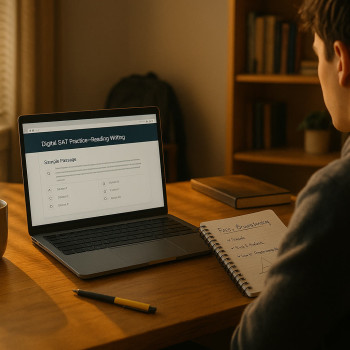AP vs SAT: Holiday/Exam Collision Playbooks
There s a special kind of tension that arrives with fall: the first sweater days, pumpkin spice (if you re into that), and the quiet dread of a calendar that looks suspiciously like a train schedule of exams. For many students and parents, the months from December through May are a collision zone between holiday family time, AP course workloads, and the Digital SAT windows. If you re juggling both AP and SAT prep (or guiding someone who is), this guide is your map through the chaos: comparisons, strategies, sample schedules, and recovery plans that are realistic, human, and yes helpful.

Why compare AP and SAT timing and strategy?
AP exams and the Digital SAT serve different but overlapping goals. AP exams are subject-focused assessments that can earn college credit or advanced placement; the Digital SAT is a general aptitude test used in admissions. Both matter to colleges and both demand time, but they ask different things of your brain, schedule, and emotions. The biggest practical reason to compare them is simple: they compete for the same resource your time and energy.
Exam seasons often collide with major holidays and critical school deadlines. Without a plan, students can end up overwhelmed, exhausted, or underprepared in both arenas. With a plan, you can turn the overlap into an efficiency engine: synchronous study habits, smarter practice choices, and strategic rest.
Core differences at a glance
Understanding the fundamental differences helps you prioritize. Here s a compact way to think of each:
- AP Exams: Deep, subject-specific mastery. Expect content-based essays, problem solving tied to course curriculum, and sometimes performance tasks or portfolios.
- Digital SAT: Broad reasoning and evidence-based reading, writing, and math skills tested under a consistent digital format. Think speed, strategy, and test-taking literacy.
- Overlap: Both reward practice, time management, and targeted feedback but the kind of practice and the feedback you need differ.
How holiday breaks change the game
Holidays are double-edged swords. They can be restorative, yet they break momentum. They re also excellent windows for focused, uninterrupted work if you plan them right. Families often expect presence and celebration; students expect the chance to study. Both can be honored if you build a realistic, humane plan.
Three holiday modes (and how to use them)
- Recharge Mode: Prioritize sleep, light review, and family. Perfect when you re within one or two weeks of an exam and need mental reset.
- Focused Sprints: Use two or three full days during a longer break (e.g., winter break) for deep AP content review or a timed SAT practice run.
- Maintenance Mode: Short daily habits (30 60 minutes) that keep concepts warm without burning you out great when you have multiple tests spread across months.
Designing a collision-proof study calendar
The heart of a good plan is a calendar that respects both your school obligations and your life. Here s a phased approach you can adapt.
Phase 1 Baseline and triage (Now to December)
Inventory everything. List AP exam dates, SAT test dates (digital administration windows), major assignments, family events, and sports/arts commitments. Rank exams by impact: which AP s are most likely to earn you credit? Which test date is non-negotiable?
- Set target scores for each AP and the SAT.
- Take one Diagnostic: a full Digital SAT practice test and a practice AP free-response or unit test to gauge gaps.
- Create a month-by-month map marking intensive blocks and light blocks (e.g., holiday weeks).
Phase 2 Build momentum (December to February)
Holidays fall here; use them strategically. If you have multiple APs in May, devote winter break to tough content (labs, long essays, portfolio work). For the SAT, schedule one full-length digital practice session during the break to simulate conditions.
- Alternate days: AP focus one day, SAT practice the next this prevents cognitive overload while keeping both areas moving.
- Use short, active review (flashcards, 20 30 minute problem sets) when returning from family obligations.
Phase 3 Sharpen and simulate (March to April)
With spring approaching, ramp up realism. For APs, take timed practice FRQs and practice multiple-choice sections under timed conditions. For the Digital SAT, take official practice tests on a laptop/tablet that mirrors the testing set-up, and work on pacing drills and digital navigation skills.
- Create mock exam weekends one full AP exam simulation and one full Digital SAT across alternating weekends.
- Analyze mistakes with a simple rubric: concept gap, careless error, time management, or misreading.
Phase 4 Final cooldown (Last two weeks before each test)
Lower the volume but keep the polish: short focused review sessions, light practice, and restorative routines. Avoid learning major new concepts in the final stretch focus on clarity and confidence.
Practical study routines that respect holidays and energy
These are routines students can actually stick to during busy seasons.
Daily 60 90 minute micro-sessions
- 20 minutes: active recall for AP (flashcards or short FRQ planning).
- 20 minutes: targeted Digital SAT practice (e.g., one math problem set or one reading passage).
- 20 30 minutes: review mistakes, annotate errors, and note one improvement for tomorrow.
Weekend deep blocks
Two 90 120 minute blocks per weekend: one for an AP subject and one for a full-length SAT section (or two shorter timed sections). After each block, a 30 45 minute review is crucial: don t just test learn from it.
Table: Direct comparison AP exams vs Digital SAT (practical lens)
| Feature | AP Exams | Digital SAT |
|---|---|---|
| Primary focus | Subject mastery (e.g., Biology, US History, Calculus) | Evidence-based reading, digital math, reasoning and pacing |
| Format | Multiple choice, free-response, portfolios/performances for some courses | Fully digital: adaptive sections, shorter modules, timed on devices |
| Typical prep style | Content review, lab practice, essay writing, long-form problem practice | Timed practice, strategy drills, digital navigation practice, pacing |
| Best holiday tactic | Focused content sprints: labs, portfolios, essay planning | Full-length practice under realistic conditions + pacing drills |
| When to prioritize | If you need college credit or course placement, prioritize APs | If admission testing is the gating factor for applications, prioritize SAT |
| How tutors help | Deep subject coaching, targeted FRQ feedback, portfolio mentoring | Strategy sessions, adaptive practice plans, pacing and device prep |
Sample 12-week plan for a simultaneous AP and SAT run
This model assumes an AP exam in early May and an optional Digital SAT test in March or May. Tailor it to your specific calendar and energy levels.
- Weeks 1 4: Diagnostic and fundamentals one AP topic each week + two SAT timed sections per week.
- Weeks 5 8: Intensity increase weekly full AP practice exams/FRQs; alternate weekends for full Digital SAT practice.
- Weeks 9 10: Error-driven focus fix the top 10 repeated errors from both APs and SAT; simulated test weekends.
- Weeks 11 12: Taper short, high-confidence reviews; sleep, nutrition, and light active practice.
Smart tradeoffs: When to prioritize one test over the other
Decision-making here is practical, not moral. Consider these rules of thumb:
- If an AP can earn you college credit or placement that saves tuition or creates a lighter first-year load, give AP priority.
- If the SAT is a critical element for a specific application deadline, or if your best testing window is earlier, prioritize SAT timing.
- If both are important and dates overlap closely, choose alternating-week intensives and communicate with teachers/coaches so everyone aligns on realistic expectations.
Study tactics that actually work (and why)
Here are field-tested tactics that respect brain science and adolescent schedules.
Interleaving beats massing
Switch between subjects and question types. Practicing math, then reading, then AP essay planning trains the brain to retrieve and apply varied skills a key advantage for both AP and SAT performance.
Active retrieval over passive review
Quizzing yourself beats re-reading notes. Use short, timed recall sessions during holidays rather than marathon reading binges.
Practice under realistic conditions
Digital SAT practice should be on a device similar to the one used for testing; AP practice should be timed and follow the exact rubric where possible. Simulation reduces anxiety and clarifies exact pacing needs.
Emotional preparedness the often-forgotten subject
Stress management is performance management. When holidays add family expectations, it s essential to communicate boundaries and set shared expectations. A short family meeting before a long break can be transformative: identify 2 3 quiet study blocks the student needs, and agree on shared activities to preserve connection.
Also, normalize failure: a low practice test score is information, not identity. Use mistakes to build targeted plans instead of spiraling into all-or-nothing thinking.
How 1-on-1 coaching (including Sparkl s personalized tutoring) fits into the playbook
Many students find that personalized tutoring accelerates their preparation in a way that calendar blocks alone do not. A few concrete benefits often cited by students and parents:
- Tailored study plans that respect holiday schedules and individual energy rhythms.
- Expert tutors who can quickly identify the 10% of errors causing 90% of your score loss.
- AI-driven insights (when available) that suggest which topics to prioritize and when to simulate exam conditions.
- Motivation and accountability a gentle but firm partner during the busiest weeks.
Sparkl s personalized approach 1-on-1 guidance, tailored study plans, expert tutors, and AI-driven insights naturally fits into the collision playbook by turning scattershot effort into surgical preparation. A tutor can create holiday micro-sprints, provide immediate FRQ feedback, and design Digital SAT pacing drills that align with your exact testing window.
Recovery protocols: What to do the day before and day of
Day-before checklist:
- Light review only no new material. Focus on high-yield summaries and formula sheets.
- Prep logistics: charger, allowed identification, testing device if required, snacks (if allowed), and water.
- Plan sleep: aim for consistent bedtime and a buffer morning so you re not rushed.
Day-of tips:
- Wake up early enough for a calm morning routine. Avoid cramming.
- Eat a balanced breakfast with protein and complex carbs; carry a small snack if allowed.
- Use breathing techniques before the test: box breath (4-4-4-4) or 2 minutes of slow diaphragmatic breathing to center attention.
- For digital testing: arrive early and confirm device settings if testing at school; practice unlocking your device and navigating practice prompts in advance.
Examples: Two student scenarios and playbooks
Example A Maya: AP Calculus AB (May 12) and Optional SAT in March
Profile: Strong in reading, needs pacing in math. Winter musical rehearsals take up evenings in December. College goal: technical school where both AP credit and a solid SAT help.
- December: Maintenance mode 6 short sessions/week (30 minutes calculus review + 20 minutes SAT pacing drills twice/week).
- Winter break: Two four-hour deep blocks: one for AP past FRQs, one for a full Digital SAT under test conditions.
- January February: Focused AP problem sets; weekly SAT timed practice on Saturday mornings. Join a Sparkl tutor for a weekly 1-on-1 math session emphasizing common calculus misreads and Digital SAT algebraic traps.
- March: Take SAT; evaluate. If improvement needed, schedule an May retest after targeted tutoring.
Example B Jamal: AP US History (May 9) and AP Chemistry (May 21), SAT in May
Profile: Busy athlete, limited weekend time for studying, strong memorization skills but weak essay structure.
- December: Use holidays for AP essay structure workshops (3 days of morning sprints). Create a one-page thesis/paragraph template Jamal can use during timed FRQ practice.
- January April: Alternate focus weeks: two weeks heavy on AP content (reading primary sources, practicing DBQs), one week of Digital SAT practice (reading and digital navigation). Use short after-school 30-minute review sessions to maintain momentum.
- April May: Simulate AP exam days on separate weekends and one full Digital SAT the weekend before the test. Enlist Sparkl s 1-on-1 feedback for DBQ and long essay reviews to polish argumentation and evidence use.
When things go off the rails: triage and recovery
Missed study blocks, family emergencies, or illness happen. Here s a simple triage rubric:
- Short disruption (1 3 days): Compress review next week no new material double down on targeted practice for the most recent weaknesses.
- Medium disruption (4 10 days): Re-run a diagnostic and re-prioritize goals. Borrow a tutor for 2 3 intensive sessions to rebuild momentum quickly.
- Long disruption (10+ days): Consider shifting one test window (if possible) or focus wholly on the highest-leverage exam and accept a later retake for the other.
Final notes: Culture, compassion, and the long view
Tests are important, but they re not the whole story. This season is an opportunity to teach planning, self-advocacy, and how to recover from setbacks. Celebrate small wins: a cleaned-up essay, a timed section that showed steady improvement, or a weekend where your schedule respected both family and study.
If you want help turning this playbook into a personalized calendar, a tutor can create a plan that fits your exact test dates, holiday commitments, and learning style. Sparkl s tutors often do precisely this customized pacing, targeted content work, and accountability that keeps students calm and confident.
Parting encouragement
When the holidays and tests collide, you re not expected to be perfect. You re allowed to be tired, to ask for help, and to prioritize what matters most in the moment. With a clear calendar, realistic routines, and occasional expert coaching, you can get through the season with your scores, your sanity, and your relationships intact. Plan the work, then plan the rest: both are exam strategies.

Ready to chart your collision playbook? Start with one 30-minute diagnostic this week, pick one priority (AP or SAT), and block three non-negotiable study sessions. Small consistent moves add up faster than frantic last-minute marathons. You ve got this.
















No Comments
Leave a comment Cancel